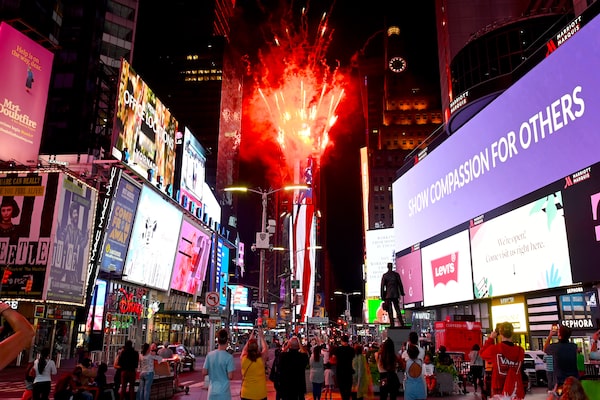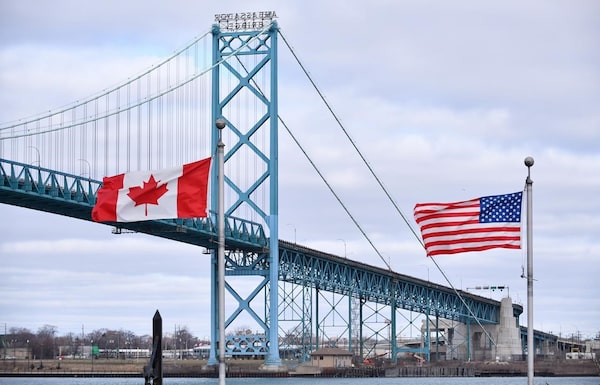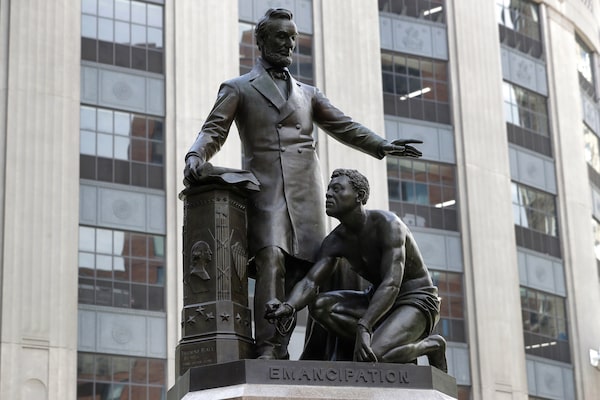
Police and a sparse crowd watch fireworks over New York City on June 29, the first of six Fourth of July displays spaced out over several days and staged at secret locations to minimize crowds and prevent the spread of COVID-19.Spencer Platt/Getty Images/Getty Images
Jared Diamond, professor of geography at UCLA, is the Pulitzer-Prize-winning author of Upheaval: Turning Points of Nations in Crisis; Guns, Germs and Steel: The Fates of Human Societies; and Collapse: How Societies Choose to Fail or Succeed, among other books.
National holidays are occasions for a nation to take stock of itself. That’s especially true if the holiday commemorates independence, as July 4 does for Americans. It’s a time to reflect on the strengths of which the country can be proud – or on the challenges lying ahead – and on the national identity that makes the country unique.
July 4, 1776, was a turning point in U.S. history. It was the day on which 13 British colonies, having reflected on their condition, declared themselves to be an independent nation. What’s the condition of the United States now, on this 244th anniversary of independence? Is the U.S. approaching another turning point, or is it even possible that the country has unknowingly already passed it? There are abundant warning signs, such as the U.S.‘s fractured political landscape, its struggles with the pandemic, its growing inequality, and its explosions of protests and riots. In some ways, it feels as if the next 244 years will be shaped by the current moment.

New York's third fireworks display was on July 1 at Times Square, where a billboard reads 'show compassion for others.'Jamie McCarthy/Getty Images/Getty Images
Before focusing on America’s problems, it’s worth taking stock of its strengths. The U.S. is the world’s richest country, with the world’s largest economy, the third-largest population and one of the highest average incomes. It has the world’s most powerful military. It leads the world in science, technology and institutions of higher education. In recent decades, far more Americans have won Nobel Prizes than have the citizens of any other country.
The U.S. enjoys permanent geographic advantages. It’s protected on two sides by wide oceans, and on the other two sides by land borders with two nations with which it enjoys peaceful relations. It has the world’s largest network of navigable internal waterways, permitting bulk transport by ship, the cheapest form of freight. Its location is entirely within the temperate zones, which are the world’s healthiest environment, as well as the most productive for agriculture. As a result, the U.S. is the world’s biggest agricultural exporter. It has large stocks of fossil fuels and of most essential minerals.
The country’s political advantages include an uninterrupted history of democratic government, whose blessings and frustrations prompted Winston Churchill’s quip: Democracy is the worst form of government, except for all of the alternative forms that at one time or another have been tried. Unlike many centralized European democracies, the U.S. has a federal system, which allows its 50 states to constitute 50 experiments for testing different government policies.
Finally, the U.S. has a history of ethnic diversity and immigration. While responses to them have often been hostile, they have been one of the U.S.’s greatest strengths, by attracting the most motivated and ambitious citizens of many countries. Among other resulting benefits, immigrants and their children have constituted a majority of American Nobel Prize winners, because the personal qualities contributing to the decision to seek a new land also contribute to success in seeking new explanations.
That’s the happy part of taking stock of the U.S.: our strengths. Now comes the unhappy part: our problems, of which there are many. In my view, the most fundamental problem today is political polarization, because it’s the problem that’s tearing America apart. The country’s national leadership instead often seeks to blame the U.S.‘s problems on other countries: especially on China, Mexico and Canada. But there is nothing that China, Mexico or Canada can do to end democratic government in the U.S. The only dangers to American democracy are being created by Americans themselves. Current developments in American governments, from the local to the national level, put the nation at risk of an end to effective democracy within the coming decade.
This polarization and breakdown of compromise are visible at many levels of government. For example, America’s two major political parties are intransigent toward each other. Within each party, challenges are growing between a radical wing and a more moderate one. The three branches of government – executive, legislative and judiciary – are increasingly at loggerheads. Within the Supreme Court, decisions by 5-to-4 votes have become the rule and unanimous votes are the rare exception. State governments and the federal government are in conflict, as reflected in lawsuits that my state of California has filed against federal policies and the federal government’s attempts to overturn California policies.
People wait in line for a pop-up food pantry in Chelsea, Mass., during the COVID-19 pandemic.Brian Snyder/Reuters/Reuters
Breakdown of political compromise does more than just fail to solve the U.S.’s other problems. It makes them worse.
Another problem is inequality, which is more extreme in the U.S. than in any other major democracy. Fewer and fewer Americans are cornering more and more of the wealth.
Related to that problem of inequality is the problem of low socio-economic mobility. “Rags to riches” is an American ideal: the belief that Americans who are born poor have a good chance, through hard work and ability, to become rich. Alas, that ideal is a myth. Americans born poor are likely to remain poor. That fact is expressed in the bitter joke, “Babies, pick your parents carefully!”
Yet another problem is low government investment in public purposes, such as education and health. Those investments would give a poor person some chance at becoming rich, but affluent Americans dismiss them as “socialism,” which is automatically considered bad.
A consequence of these interlocked problems is that the U.S. is squandering the advantages I discussed at the outset. Yes, we do have the world’s third-largest population (about 328 million people) and one of the world’s highest average incomes. But most of those 328 million Americans aren’t enjoying the benefits of the country’s wealth, productivity and institutions of higher education. America isn’t investing in most Americans, and so they aren’t realizing their potential to contribute to our productivity.
In effect, the U.S. is a country of 328 million inhabitants that operates as if only 50 million of them matter. That’s throwing away the advantage of the U.S.’s large population. If the U.S. continues down this path, it will be just a matter of time until the country is overtaken by other populous nations that do invest in most of their citizens – such as Germany, Japan and (increasingly) China.

Attendees at a Boston Juneteenth event face off against a man in a pro-Trump mask and hat. Juneteenth is the celebration of when the last enslaved African-Americans learned in 1865 that they had been freed by the Emancipation Proclamation two years earlier.Michael Dwyer/The Associated Press/The Associated Press
What explains our recent growth in political polarization?
Often-suggested causes include the fragmentation of mass media and the growth of domestic air travel that lets representatives in Congress return to their home states on weekends instead of staying in Washington and socializing with each other. But those explanations seem to me just proximate causes, because polarization is not only political; it’s a broader social phenomenon.
I speculate that an underlying cause is our decline in face-to-face communication. For the first six million years of human and proto-human history, all communication was face to face: looking at people in the eye, hearing their voice, reading their body language and experiencing them as human beings. That began to change slowly only 5,500 years ago, with the invention of writing, much later with mass literacy, and then with the appearance of radio and telephone within the previous century. Today, thanks to the internet and cellphones, we experience other people mostly as words on a screen. However, our inhibitions against being abusive to a live person don’t apply to words on a screen.
That’s my hypothesis. But whatever the cause of the U.S.‘s rising political polarization, the consequences are clear: declines in democracy, compromise and investment in public purposes; and destructive riots, which recently broke out in Los Angeles for the third time since I moved here in the 1960s. If current trends don’t change, we’ll surely experience much worse.
Many factors converged to provoke the riots. Americans are losing faith in American democracy – too many Americans are prevented from voting, and too many of those who aren’t prevented from voting don’t bother to vote. Rage at America’s long history of racial inequality and of police brutality is growing. Economic inequality is flagrantly visible in Los Angeles, where hundreds of thousands of desperately poor people live only a few miles from the ostentatious wealth of Beverly Hills.

A masked woman leans the front windows of a Gucci store on Rodeo Drive in in Beverly Hills, Calif.Ashley Landis/The Associated Press/The Associated Press
How can Americans reverse these dangerous trends? July 4 is a good occasion for reflecting.
One thing for Americans to do is to learn from how other countries deal with the same problems that the U.S. faces. Voter registration, health, education and prisons aren’t uniquely American problems; all democracies have to resolve them. Many countries deal with those problems more successfully, more cheaply and to the greater satisfaction of their citizens than do Americans. But Americans refuse to consider solutions adopted by other countries because of a belief in “American exceptionalism.” That means the conviction that the United States is so unique that it has nothing to learn from other countries and that what works elsewhere couldn’t work in the U.S.
Yes, the U.S. is exceptional. But so are Canada, Cuba, Cambodia, Cameroon, Congo and Costa Rica. It would be as feasible for the U.S. government as it is for Italy’s government to mail a notice of voter registration to every citizen in advance of an election. It would be as feasible for the U.S. government as it is for Japan’s government to equalize educational levels nationally by sending more teachers, rather than fewer teachers, to poor rural areas with low educational performance.
Especially surprising is American ignorance about our neighbour Canada. We Americans take Canada for granted, because it shares with the U.S. the same system of telephone area codes, the same majority language and the world’s longest land border. We don’t realize how different Canadian society and policies are from those of the U.S. We refuse to learn from how Canada solves issues of health care and immigration that frustrate Americans.

Canadian and U.S. flags fly near the Ambassador Bridge in Windsor, Ont.Rob Gurdebeke/The Canadian Press/The Canadian Press
What else can Americans do to reverse these troubling trends? Another step would be to focus less on differences and more on shared national identity – the things that evoke pride and that bring people together. A shared identity is vital for countries facing a crisis.
That’s obviously true when the crisis is caused by a dangerous foreign power. I’ve spent much time in two countries where shared memories of a successful struggle against a powerful enemy became a potent unifying force. One of those countries was the United Kingdom, with its memory of the 1940 Battle of Britain, when it stood alone against threatened invasion by Nazi Germany and prevailed. The other country was Finland, which preserved its independence by fighting the enormously larger armies of the Soviet Union to a standstill in the Winter War of 1939-40.
Both Britain and Finland suffered from divisive issues, as does the U.S. today: Britain from its class differences, and Finland from the legacies of its deadly civil war. But both British and Finnish people set aside their differences in order to defeat their dangerous enemy. When I was visiting Britain and Finland a generation later, its citizens still had confidence that, since they had prevailed then against overwhelming odds, they could also prevail against the current problems facing them.
Might COVID-19 be such a uniting force for the U.S. today? Like Britons and Finns in 1940, Americans now face a common enemy – not a visible one equipped with guns, as were the Luftwaffe and Joseph Stalin’s armies, but an invisible one. True, the pandemic’s burden is unequal among American states, and unequal between rich and poor Americans. But the coronavirus ultimately threatens all Americans, regardless of their geographic location and income. Even if one state succeeded in eliminating the virus within its borders, its citizens would just get reinfected from other states. No American will be safe from COVID-19 until all Americans are safe from COVID-19.

A masked Bostonian walks past a mural honouring Frederick Douglass, a 19th-century Black abolitionist.Charles Krupa/The Associated Press/The Associated Press
I recently revisited the city of my birth, Boston, in which my son Max was then living. When I asked Max how he would like to spend the day, he suggested we tour the nearby battlefields of Concord and Lexington, where the U.S. War of Independence had begun on April 19, 1775. I had often visited those towns while growing up and so I expected nothing more of the occasion than an opportunity to be with my son.
In fact, returning to those battlefields after my previous visit, 60 years earlier, I found myself overwhelmed by the experience. That was where the American quest for freedom had begun! It began there against odds as daunting as the odds that Finland faced against Stalin’s armies: In our case, outnumbered civilians facing trained troops.
That visit suggested to me a possible answer to the question: How can a leader unite a fractured country, by appealing to all of its citizens? That’s an important question today, when the U.S. has a president intent instead on demonizing many groups of Americans.
A prime example of a unifying message by a U.S. leader was president Abraham Lincoln’s famous Gettysburg Address, which he delivered to commemorate the Battle of Gettysburg, fought on July 1-3, 1863. The U.S. was engaged then in a bloody civil war, in which Lincoln was the leader of the North. The temptation was obvious to denounce the other side, the South, for seceding. Yet Lincoln’s Gettysburg Address denounced no one. It didn’t even use the words “North” or “South.” It aimed instead to appeal to all Americans. Think of the unifying words Lincoln did use in his address: “we,” “our fathers,” “all men are created equal,” “brave men living and dead,” “the great task remaining before us,” “this nation,” “the people … the people … the people.”

A Boston statue shows a freed slave kneeling at Abraham Lincoln's feet.Steven Senne/The Associated Press/The Associated Press
What should a U.S. president do today? Of course, start by using July 4 to appeal to all Americans – stressing what is shared, what all Americans can be proud of and the country’s common tasks. A president intent on fostering American unity would use July 4, and the anniversary of Concord and Lexington, and the anniversary of Lincoln’s Gettysburg Address, and other occasions throughout the year, as opportunities to appeal to national unity.
Regardless of whether the U.S. president after the coming November election proves to be Joe Biden or Donald Trump, he will have to grapple with a host of daunting challenges. They include COVID-19; a staggering economy; a fragmented electorate, Congress and Supreme Court; and the pent-up rage of all those Americans who have already been driven to protest or to riot.
What’s at stake for the U.S.? Rich, powerful countries can throw away their advantages. COVID-19 is not only a national problem for the U.S., demanding a national solution; it’s a global problem demanding a global solution. In recent years, the U.S. has abrogated its role as world leader. A U.S. that continues to be polarized will not only fail to solve U.S. problems. It also won’t contribute to solving the most pressing global problems: climate change, resource depletion, inequality and the continued risk of nuclear war.
July 4 is a good occasion for Americans, who have arrived at another turning point in their nation’s history, to consider the various paths forward and decide what kind of country the United States should be.

New Yorkers enjoy some physically distanced fireworks.Spencer Platt/Getty Images/Getty Images
Keep your Opinions sharp and informed. Get the Opinion newsletter. Sign up today.